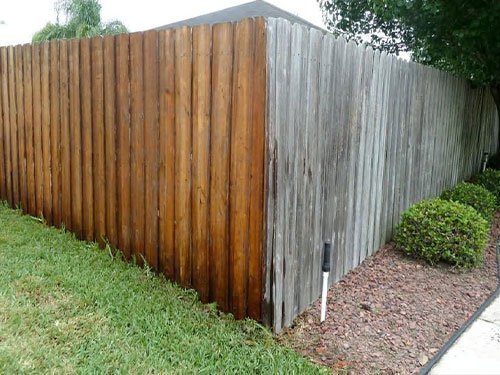Important Tips for Deck Staining Success
Attaining a perfectly stained deck requires even more than simply a brush and a container of discolor. From choosing the right kind of tarnish to grasping the art of application, each stage plays a critical duty in the final end result.
Selecting the Right Spot
Picking the proper stain is paramount in attaining a long lasting and aesthetically pleasing surface for your deck. deck cleaning near me. When picking a stain for your deck, it is crucial to consider variables such as the wood kind, wanted shade, degree of protection required, and upkeep choices
Firstly, take into consideration the type of wood your deck is made of, as different timber species might react in a different way to particular types of discolorations. Hardwoods like oak or mahogany may call for different discolorations compared to softwoods like ache or cedar. Comprehending the attributes of the timber will certainly aid you choose a stain that passes through effectively and improves its natural elegance.
Following, consider the color you want for your deck. Discolorations come in a range of tones, from natural tones that improve the wood's grain to more nontransparent shades that provide better UV security. Choose a shade that complements your outside space and matches your aesthetic preferences.
Moreover, assess the level of defense the tarnish deals. Some stains offer a lot more substantial protection versus UV rays, dampness, and mold, which can lengthen the life of your deck. Stabilizing security with visual appeals is key to achieving a durable and aesthetically appealing finish.
Preparing the Deck Surface Area
To make sure a successful application of the chosen discolor, thorough preparation of the deck surface is essential. Utilize a deck cleaner or wood brightener along with a stiff-bristled brush to scrub the surface clean.
Replace or repair these as needed to make certain the structural integrity of the deck. This step not only helps the discolor adhere better yet also improves the overall appearance of the deck.
Using the Spot Properly

Begin by extensively blending the discolor to make sure an even consistency. Make use of a paint stirrer to blend the tarnish well, particularly if it has actually best site been sitting for a while. When applying the stain, utilize a sprayer, paintbrush, or roller , depending upon the kind of stain and the size of the deck. Job in workable areas to avoid the tarnish from drying out erratically. Use the discolor in the direction of the timber grain to make sure even insurance coverage and a professional surface.
Allow the first layer to completely dry completely before deciding if a 2nd layer is necessary. Adhere to the maker's guidelines concerning drying out times and reapplication. Proper application of the discolor is crucial for safeguarding your deck and improving its look for many years to come.
Maintaining Your Tarnished Deck
After effectively applying the tarnish to your deck, maintaining its look and safety top qualities is essential for long-lasting longevity and visual appeal. Routine maintenance is key to maintaining the elegance and honesty of your stained deck. To keep your deck looking its best, it is advised to cleanse it a minimum of yearly. Use a light detergent and water to get rid of dirt, grime, and mold that can build up externally. Furthermore, evaluate your deck every year for any indicators of wear or damages. Dealing with problems promptly can avoid them from worsening and extend the life of your stained deck. Depending upon the foot web traffic and exposure to the components, you may require to reapply a fresh coat of stain every 2-4 years. This will help preserve the shade and safety finish of your deck, making sure that it here remains to boost your outdoor area for several years to come.

Troubleshooting Common Issues
Determining and addressing common problems that might arise with your stained deck is crucial for guaranteeing its longevity and ideal efficiency. One common trouble is flaking or peeling of the stain.
An additional problem typically come across is mold and mildew and mold development on the deck surface. This can be credited to moisture retention, absence of sunlight, or inappropriate ventilation. To tackle this trouble, a comprehensive cleansing with a mold and mildew eliminator complied with by proper drying out and application of a mold-resistant tarnish is important.
Additionally, fading of the tarnish shade with time is a widespread concern. UV direct exposure and harsh weather can trigger staining. To address this, choosing a top quality, UV-resistant discolor and applying a fresh coat occasionally can assist keep the deck's aesthetic allure.

Conclusion
In verdict, successful deck staining requires selecting the ideal discolor, properly preparing the deck surface, applying the tarnish properly, and maintaining the tarnished deck. By complying with these crucial ideas, you can achieve a wonderfully tarnished deck that enhances the total look of your outdoor area. Bear in mind to repair any typical problems that might develop during the discoloration process to make sure a visually attractive and resilient result.
Achieving a perfectly discolored deck needs even more than just a brush and a container of discolor.To make certain an effective application of the selected tarnish, complete prep work of the deck surface is necessary. When using the discolor, make use of a paintbrush, roller, or sprayer , depending on the type of tarnish and the size find of the deck.Determining and dealing with usual issues that might emerge with your discolored deck is important for guaranteeing its longevity and optimum efficiency.In conclusion, effective deck discoloration requires selecting the ideal discolor, appropriately preparing the deck surface area, using the tarnish properly, and keeping the discolored deck.